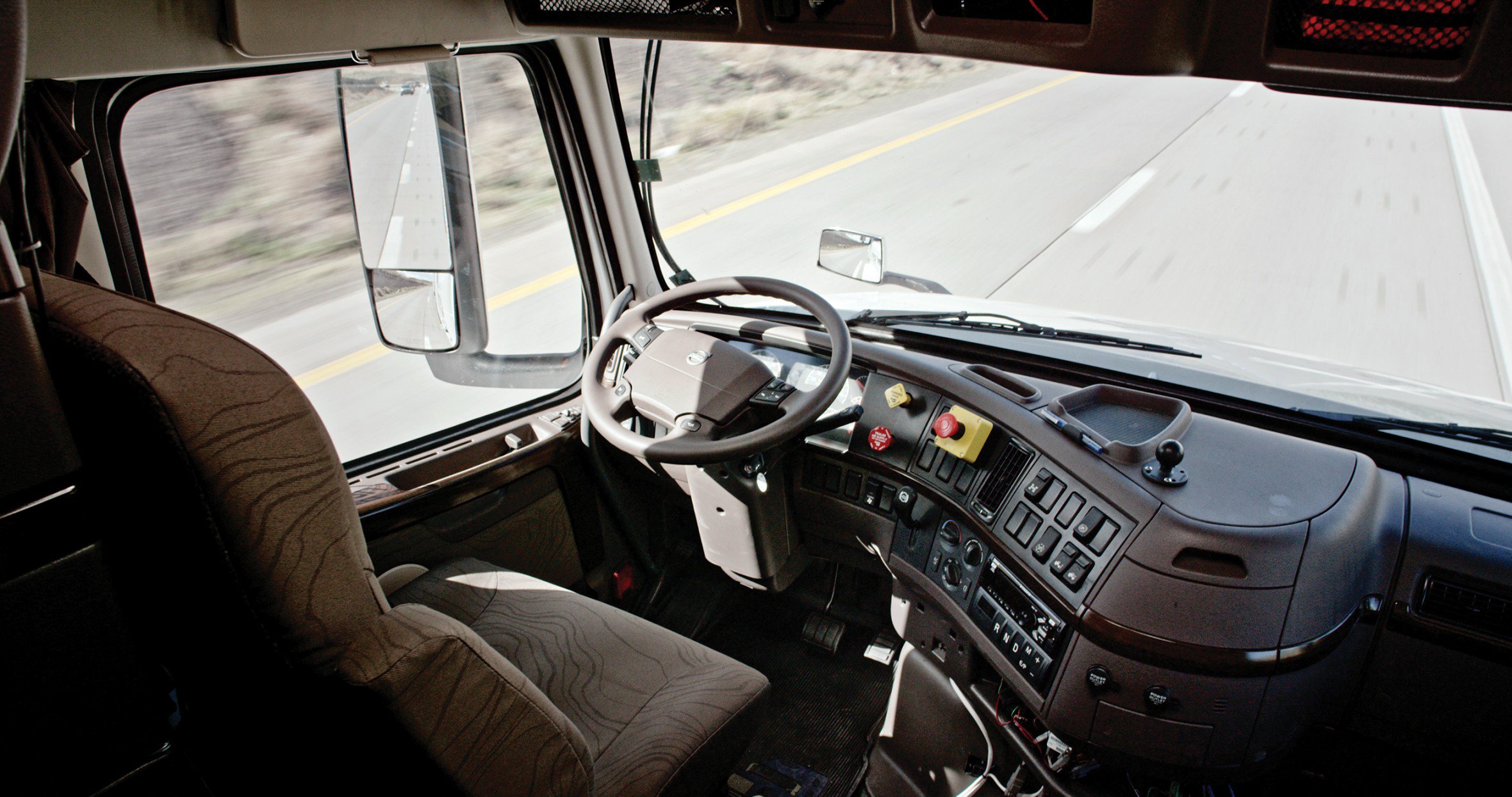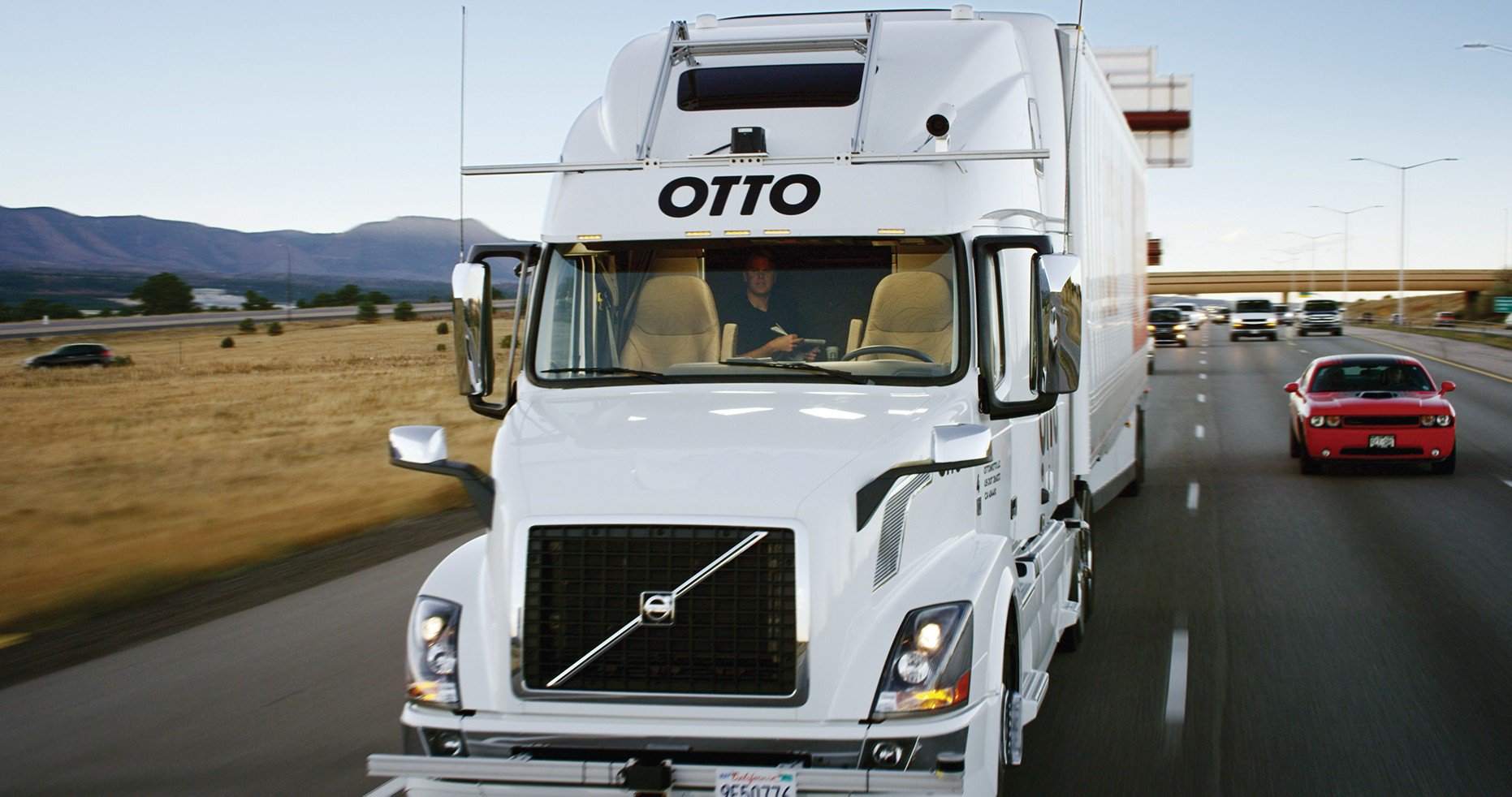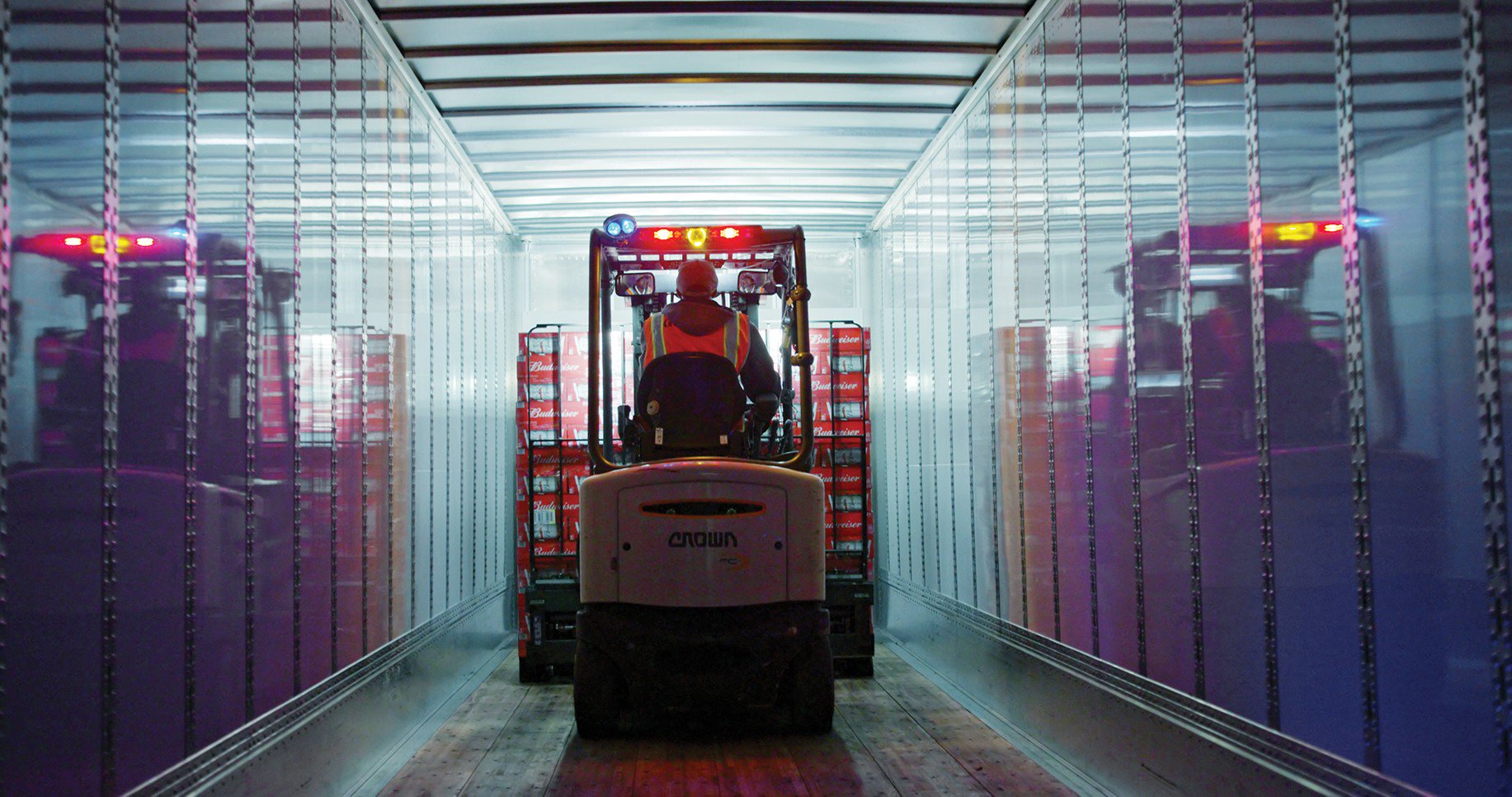Self-Driving Trucks
Self-Driving Trucks
Breakthrough
Long-haul trucks that drive themselves for extended stretches on highways.Why it matters
The technology might free truck drivers to complete routes more efficiently, but it could also erode their pay and eventually replace many of them altogether.Key players
Otto; Volvo; Daimler; PeterbiltAvailability
5 to 10 years
Roman Mugriyev was driving his long-haul 18-wheeler down a two-lane Texas highway when he saw an oncoming car drift into his lane just a few hundred feet ahead. There was a ditch to his right and more oncoming cars to his left, so there was little for him to do but hit his horn and brake. “I could hear the man who taught me to drive telling me what he always said was rule number one: ‘Don’t hurt anybody,’” Mugriyev recalls.
But it wasn’t going to work out that way. The errant car collided with the front of Mugriyev’s truck. It shattered his front axle, and he struggled to keep his truck and the wrecked car now fused to it from hitting anyone else as it barreled down the road. After Mugriyev finally came to a stop, he learned that the woman driving the car had been killed in the collision.
Could a computer have done better at the wheel? Or would it have done worse?
We will probably find out in the next few years, because multiple companies are now testing self-driving trucks. Although many technical problems are still unresolved, proponents claim that self-driving trucks will be safer and less costly. “This system often drives better than I do,” says Greg Murphy, who’s been a professional truck driver for 40 years. He now serves as a safety backup driver during tests of self-driving trucks by Otto, a San Francisco company that outfits trucks with the equipment needed to drive themselves.
At first glance, the opportunities and challenges posed by self-driving trucks might seem to merely echo those associated with self-driving cars. But trucks aren’t just long cars. For one thing, the economic rationale for self-driving trucks might be even stronger than the one for driverless cars. Autonomous trucks can coördinate their movements to platoon closely together over long stretches of highway, cutting down on wind drag and saving on fuel. And letting the truck drive itself part of the time figures to help truckers complete their routes sooner.
But the technological obstacles facing autonomous trucks are higher than the ones for self-driving cars. Otto and other companies will need to demonstrate that sensors and code can match the situational awareness of a professional trucker—skills honed by years of experience and training in piloting an easily destabilized juggernaut, with the momentum of 25 Honda Accords, in the face of confusing road hazards, poor surface conditions, and unpredictable car drivers.
And perhaps most important, if self-driving trucks do take hold, they figure to be more controversial than self-driving cars. At a time when our politics and economy are already being upended by the threats that automation poses to jobs (see “The Relentless Pace of Automation”), self-driving trucks will affect an enormous number of blue-collar workers. There are 1.7 million trucking jobs in the U.S., according to the Bureau of Labor Statistics. Technology is unlikely to replace truckers entirely anytime soon. But it will almost certainly alter the nature of the job, and not necessarily in ways that all would welcome.
“We’re not waiting”
Otto’s headquarters, in the once-seedy South of Market section of San Francisco, isn’t much like many of the other tech startups that have transformed the area. Proudly oblivious to that neighborhood upgrade, it’s a barely renovated former furniture warehouse converted to a garage and machine shop, with semi trucks in various states of dismantlement hulking over benches of tools and computers. “No fancy, shiny offices here,” brags Eric Berdinis, Otto’s young and clean-cut-looking product manager.
Berdinis shows off the latest generation of the company’s fast-evolving technology, which is currently installed on Volvo semis. Unlike the bolted-on, kludgy-looking hardware that’s been on testing runs for the past year, the newer versions of the company’s sensor and processing arrays are more sleekly integrated throughout the Volvo cab. The equipment includes four forward-facing video cameras, radar, and a box of accelerometers that Berdinis boasts is “as close as the government allows you to get to missile-guidance quality.”
Particularly key to Otto’s technology is a lidar system, which uses a pulsed laser to amass detailed data about the truck’s surroundings. The current third-party lidar box costs Otto in the vicinity of $100,000 each. But the company has a team designing a proprietary version that could cost less than $10,000.
Inside the cab is a custom-built, liquid-cooled, breadbox-size micro-supercomputer that, Berdinis claims, provides the most computing muscle ever crammed into so small a package. It is needed to crunch the vast stream of sensor data and shepherd it through the guidance algorithms that adjust braking and steering commands to compensate for the truck’s load weight. Rounding out the hardware lineup is a drive-by-wire box to turn the computer’s output into physical truck-control signals. It does this through electromechanical actuators mounted to the truck’s mechanical steering, throttling, and braking systems. Two big red buttons in the cab—Otto calls them the Big Red Buttons—can cut off all self-driving activity. But even without them, the system is designed to yield to any urgent tugs on the steering wheel or heavy pumps of the pedals from anyone in the driver’s seat.
Otto was founded early in 2016 by Anthony Levandowski, who had been with Google’s self-driving-car effort, and Lior Ron, who headed up Google Maps, along with two others. It was a natural move to build on Google’s vast experience with its autonomous cars, which have driven more than two million miles on U.S. roads in several states, with an eye toward the four million trucks in the U.S. alone. Volvo Trucks, Daimler Trucks, and Peterbilt have been working on their own autonomous-truck technology.
Even if drivers stay on in the cab, it’s not clear the economics will work out in their favor.
Then, as further validation, Uber snatched Otto up for a reported $680 million last August. That deal has given Otto’s team access to roughly 500 engineers at Uber working on self-driving technology, according to Berdinis. Levandowski now heads that effort for Uber, which has said it envisions providing an overarching and largely automated transportation network for both goods and people.
Otto has only seven trucks on the road with its technology, but it hopes owners of many more trucks will eventually take on the equipment for free to test it out. Berdinis says the company is working to drive down the cost of the technology to the point where it offers a one- or two-year payback. That’s likely to mean something in the vicinity of $30,000 for a retrofit. “We expect the government to mandate this technology eventually, and for truck manufacturers to integrate it into their vehicles,” says Berdinis. “But new-truck development is on an eight-year cycle, and we’re not waiting.”
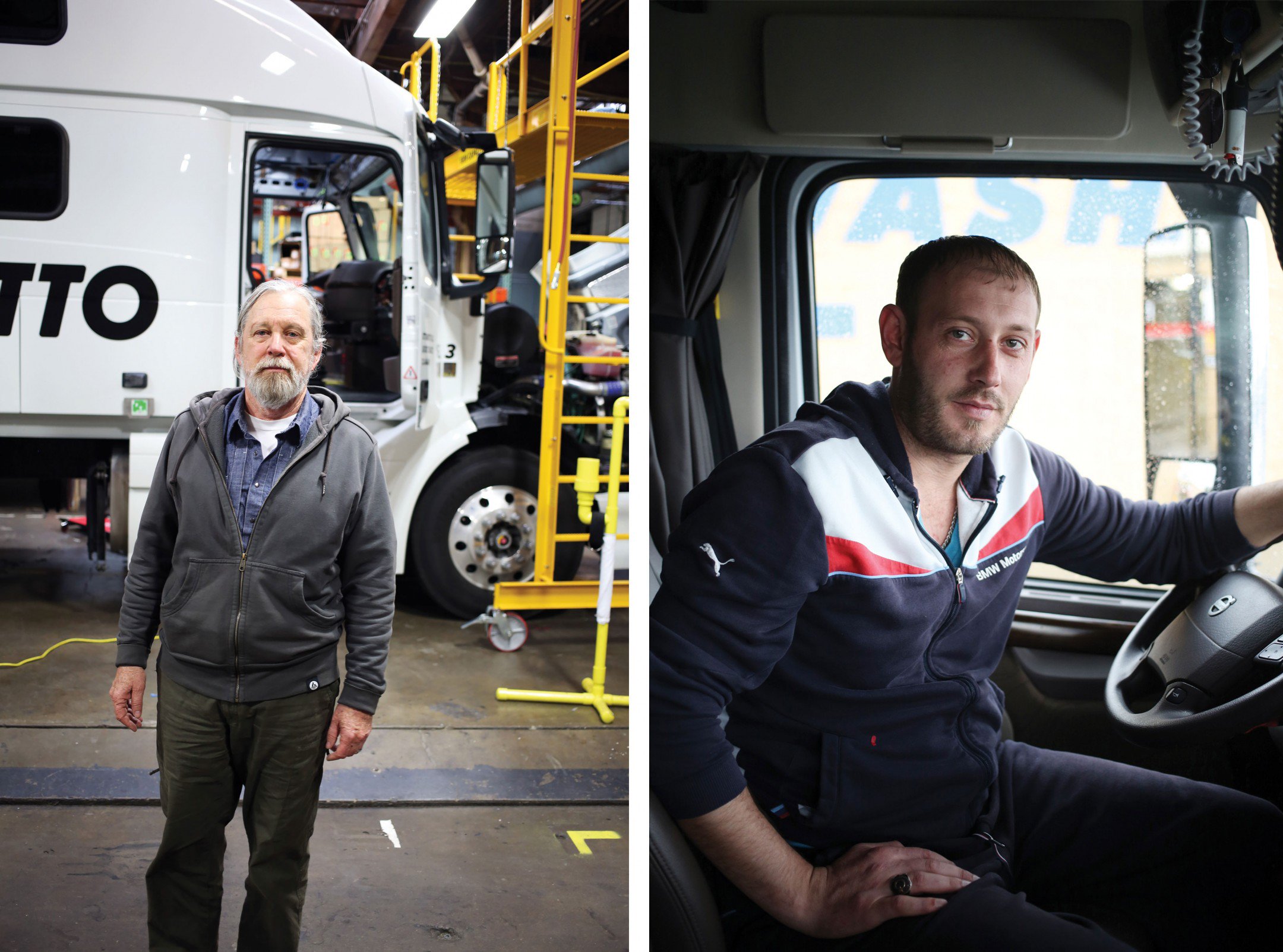
Roman Mugriyev, right, wonders how well self-driving trucks would handle dangerous situations.
Pay cuts
Last October an Otto-outfitted self-driving truck carried 2,000 cases of Budweiser beer 200 kilometers down Interstate 25 in Colorado from Fort Collins to Colorado Springs—while the truck’s only human driver sat in the sleeper berth at the back of the cab without touching the vehicle’s controls.
That commercial delivery, the first ever to be handled by an autonomous heavy truck, illustrated the potential of the technology. But it also demonstrated the current limitations. The human driver piloted the truck to and from the highway the old-fashioned way, because the technology doesn’t drive on small rural roads or in cities. Even after it was on the highway, a car drove ahead of the truck to make sure the far right lane remained clear. Otto’s system is programmed to stay in that lane, because on many roads trucks are restricted to the far right and are generally considered safer there. And the truck was surrounded by several cars carrying Otto personnel and Colorado State Patrol staff.
In all other testing of Otto-equipped trucks, a professional driver like Greg Murphy sits in the driver’s seat, constantly ready to take the controls at a moment’s notice, even on the highway. Another Otto employee is in the cab as well. Murphy hits the Big Red Buttons when there’s debris on the road, or construction. “My hands are always on the wheel, and I have to concentrate pretty hard to be ready,” says Murphy. “It’s actually harder than normal driving.” (I was invited to sit in on an Otto test ride, but shortly before I was due to show up I was told there had been a scheduling miscommunication and a truck wouldn’t be available. I suspect the cancellation had more to do with that morning’s heavy rain—which can throw off autonomous vehicles—but Otto stuck to its story.)
In fact, Otto insists it has no plans to release products intended to operate trucks without a driver in the cab. “We’re at least a decade away from having trucks with no driver in it,” says Berdinis. But Otto does expect to free up the driver during highway cruising to remain in the back of the cab relaxing, working, or even napping. And therein lies the strongest part of the economic case for self-driving trucks. Drivers are legally restricted to 11 hours of driving a day and 60 hours a week. Given that a new big rig goes for about $150,000, and taking into account the vast delays that pulling over to rest injects into the movement of goods, trucks that can cruise nearly 24/7 could dramatically lower freight costs.
There are other anticipated savings from having trucks drive themselves across America’s 230,000 miles of highway. Fuel is about a third of the cost of operating a long-haul truck, and while drivers are capable of wringing maximum miles per gallon from their trucks, many are too heavy-footed on the pedals. (Berdinis says the best drivers are 30 percent more fuel-efficient than the worst ones.) Otto’s equipment is programmed to keep trucks pegged to optimal speeds and acceleration.
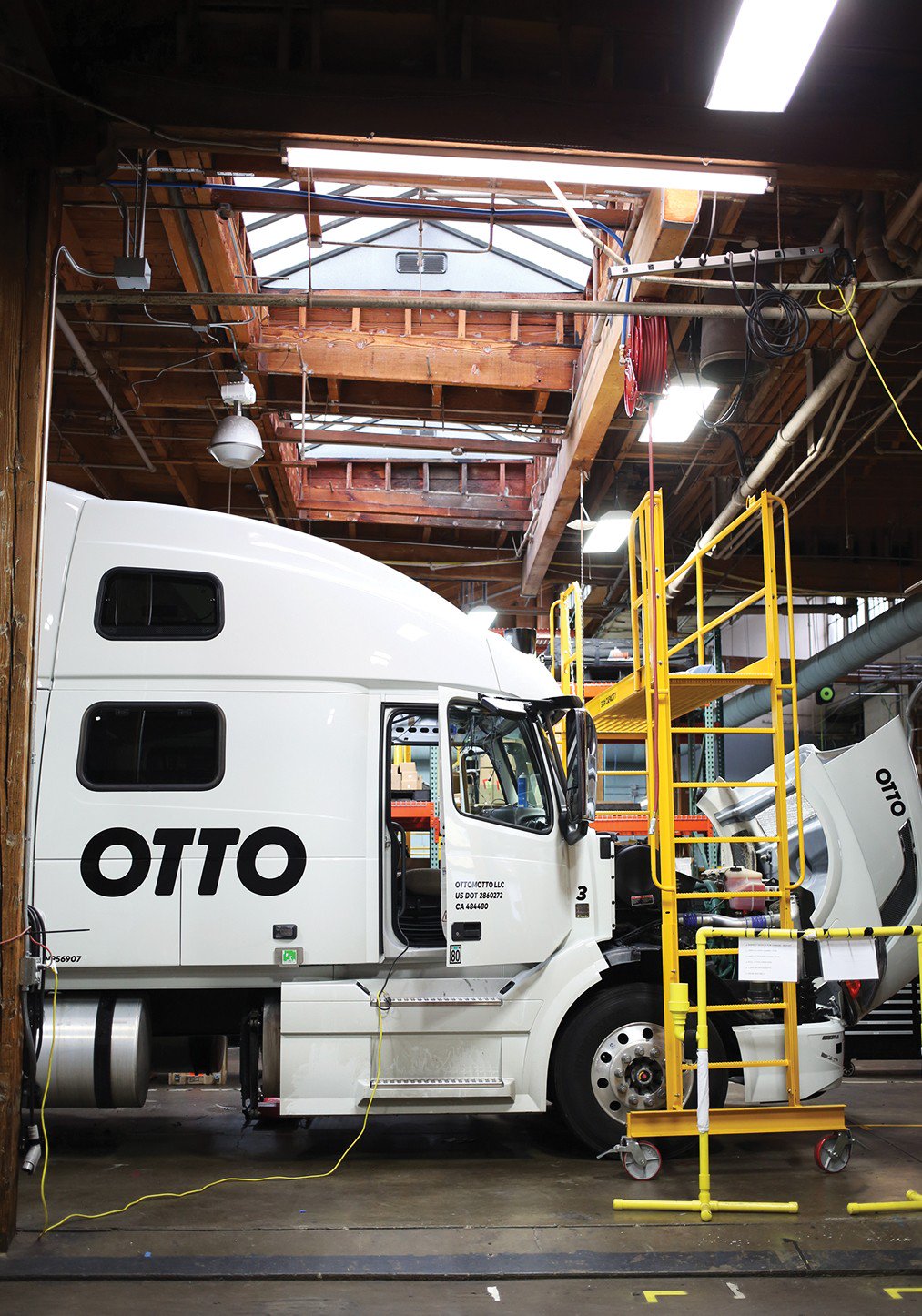
Then there’s the potential to cut down on accidents. Truck and bus crashes kill about 4,000 people a year in the U.S. and injure another 100,000. Driver fatigue is a factor in roughly one of seven fatal truck accidents. More than 90 percent of all accidents are caused at least in part by some form of driver error. We don’t yet know what fraction of those errors would be eliminated by autonomous technology—or what new errors might be introduced by it—but tests of self-driving cars suggest the technology will cut down on mistakes.
As long as self-driving trucks require a driver to remain on board, driving jobs seem safe. In some ways those jobs, which pay an average of about $40,000 a year, could even improve. For one thing, driving a truck 11 hours a day is stressful. “You get physically and mentally tired,” says Mugriyev, the driver in the Texas accident, which occurred in 2013. (He was not found to be at fault.) Besides being able to nap and relax in the cab while Otto does the driving, says Berdinis, drivers could use the time away from the wheel to catch up on trucking’s heavy paperwork, locate a “backhaul” load that would pay for the return trip, chat with family and friends, learn a second trade, or run a business. “And while they’re doing it, the drivers are still getting paid for driving,” he says.
These potential benefits could help with recruiting and training truck drivers—a key concern, because there’s actually a big shortage of drivers in both the U.S. and Europe. The American Trucking Associations pegs the current U.S. shortage at about 50,000 drivers and predicts that a total of nearly 900,000 new drivers will be needed over the next eight years. “We have customers calling us up saying they’ll buy 10 new trucks from us if we can provide the drivers, too,” says Carl Johan Almqvist, who heads product safety at Volvo Trucks.
One endorsement of the potential benefits of autonomous trucks to both trucking companies and drivers has come from the state government of Ohio, a trucking hub that’s home to more than 70,000 drivers. The state has committed $15 million to set up a 35-mile stretch of highway outside Columbus for testing self-driving trucks. The heads of both the American Trucking Associations and the Ohio Trucking Association have publicly suggested that autonomous trucks will be good for truckers.
However, the technology is not just a way to make the job more attractive to human drivers; it’s potentially a way for trucking companies to fill in for drivers who aren’t available. And if self-driving systems someday become accepted as capable of standing in for drivers, why keep human drivers on at all? After all, drivers account for a third of the per-mile costs of operating a truck.
Even if, as is likely for the foreseeable future, drivers stay on in the cab of self-driving trucks, it’s not clear the economics will work out in their favor. That’s because there’s currently no regulation that would require companies to pay drivers for the time they spend in the back of the cab. What’s more, freight companies are likely to be forced to convert the cost savings from always-rolling trucks into lower hauling charges in order to compete. Those dropping fees could put pressure on truckers’ pay. “If load prices get pushed down with this technology, the company will say, ‘You didn’t do as much driving, so you don’t make as much,’” says Mugriyev.
Safety questions
Is Otto’s technology up to safely piloting 80,000 pounds of truck down a busy highway? Having a driver in the cab won’t do much to make up for any shortcomings in the system, given that by Otto’s own reckoning it can take up to 30 seconds for a driver resting in the back to fully orient to the driver’s seat.
The extensive history racked up by Google’s self-driving cars is encouraging, with only 20 crashes over seven years and millions of miles. Only one of the crashes was found to be the fault of the car: a traffic merging situation of the sort that Otto hands off to the driver.
But that record doesn’t easily translate into a prediction for the safety of self-driving trucks. As Berdinis notes, trucks can’t swerve to avoid a hazard the way cars can. A fast, hard turn of the steering wheel at high speed would set the truck to fishtailing and possibly jackknifing. From the moment the brakes are applied in a truck going 55 miles per hour, it takes well over the length of a football field for the vehicle to stop. There are only six inches of lane on either side of a truck, meaning even small hazards at the side of the lane can’t be avoided without leaving the lane. “Many avoidance algorithms for self-driving cars just don’t apply to trucks,” says Berdinis.
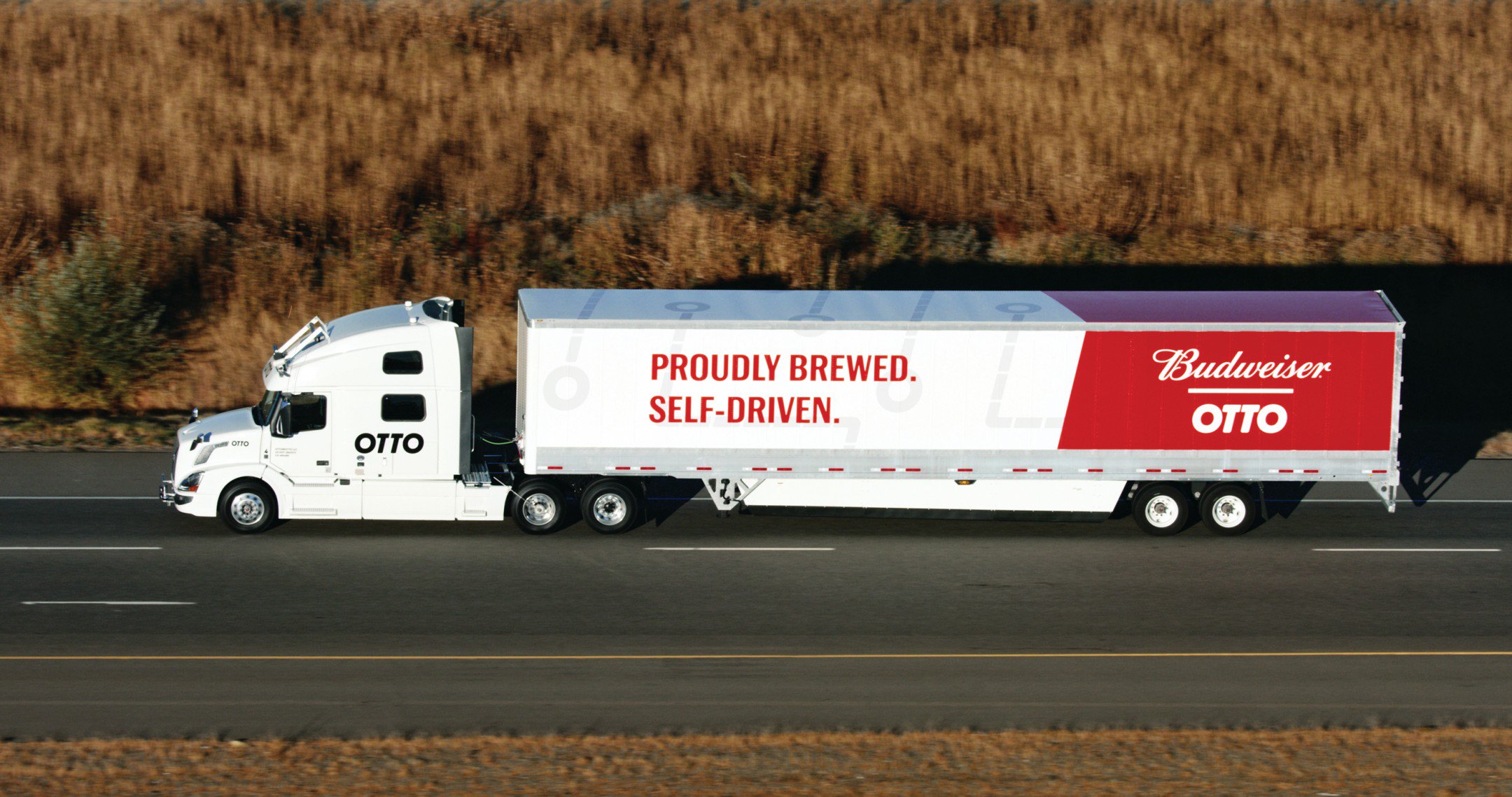
One advantage for trucks is that some of the sensors can be mounted at the top of the cab, providing a high-up view that can see over traffic far ahead. But even state-of-the-art sensors can struggle to provide accurate, unambiguous data. Bright sunlight can briefly blind cameras, computers can’t always differentiate between a car by the side of the road and a big sign, and systems can be thrown off by snow, ice, and sand. They also can’t interpret facial expressions and gestures of nearby drivers to predict the driving behavior of other vehicles. And few systems would be able to differentiate between a hitchhiker and a construction worker gesturing to pull over.
Self-driving cars have managed to do well in mostly city driving in spite of these limitations, but at highway speeds and with limited maneuverability, trucks may come up short more often. “We’re still having problems with these challenges,” says Volvo Trucks’ Almqvist. Heavy-truck drivers typically spend months in driving school, and go through thousands of miles of supervised driving, before taking full charge of a big rig. Thus, matching a human driver’s skill is harder for a self-driving truck than it is for a self-driving car. Mugriyev wonders, for example, if an autonomous system would be able to do what he did: wrestle to a safe stop a truck with a blown front axle and a smashed-up car pasted to its front.
Because of such safety concerns, Volvo has no current plans to field its autonomous trucks on public roads. Instead, it intends to limit them to private locations such as mines and ports. “On public roads, we’ll use the technology to support the driver, not to replace the driver,” says Almqvist. Volvo is still unsure about social acceptance of the technology. The company sometimes identifies the license plates of passing cars when testing its autonomous trucks, and then tracks the car owners down and surveys them about their perceptions.
Berdinis acknowledges the challenges, but he insists Otto’s technology is rapidly evolving to meet them. “We won’t ship until we’re confident there are no situations where we’d need a human to immediately take control of the truck,” he says.
Otto will also have to convince regulators its systems are ready for the highway. Unlike Uber, which has relied on the consumer popularity of its passenger service to take to the roads first and wrestle with regulations later, Otto will do everything strictly by the book, notes Berdinis.
Even Volvo’s Almqvist thinks the technology will make it to public roads in the not-too-distant future. But timing will be crucial, he adds: “If we do it too soon and have an accident, we’ll hurt the industry. And if you lose the public’s trust, it’s very difficult to regain it.”
Keep Reading
Most Popular
Large language models can do jaw-dropping things. But nobody knows exactly why.
And that's a problem. Figuring it out is one of the biggest scientific puzzles of our time and a crucial step towards controlling more powerful future models.
The problem with plug-in hybrids? Their drivers.
Plug-in hybrids are often sold as a transition to EVs, but new data from Europe shows we’re still underestimating the emissions they produce.
Google DeepMind’s new generative model makes Super Mario–like games from scratch
Genie learns how to control games by watching hours and hours of video. It could help train next-gen robots too.
How scientists traced a mysterious covid case back to six toilets
When wastewater surveillance turns into a hunt for a single infected individual, the ethics get tricky.
Stay connected
Get the latest updates from
MIT Technology Review
Discover special offers, top stories, upcoming events, and more.
